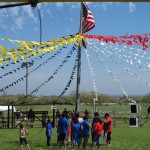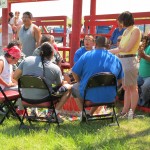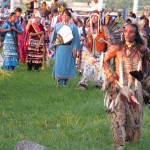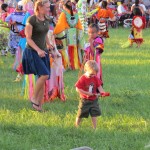June 25, Yankton Sioux Pow-wow
We awoke to the charismatic announcer, Jerry, crooning over the PA a song in the tonality and rhythm of those we had heard the night before. It was in English though, something about an elephant.
The first business of the day was recognition of the veterans and the raising of the American flag to songs of victory. At the evening ceremony Jerry would chide the singers for playing too long, as some of the veterans complained that this morning’s enthusiastic victory song was hard on their old wounds. Indeed, a footless veteran, who later would give Brady a drumstick, danced from his wheelchair along with the others that circled the center flagpole. Respect for the men and women warriors of the Lakota, Dakota, and Nakota tribes was fierce.
I chatted next with the lead singer from the Hilltop Singers drum circle. He told me a story alternate to the textbooks about Little Bighorn, the battle where Custer fell and the victorious Sioux captured an American flag, the whereabouts of which is locally known, but purposely undisclosed here…
The singer told me about the meanings of some songs and that he is a maker of songs. He told me about a traditional way of making songs that involves sitting still and using the hills as a reference for a melody’s pitch.
Runners arrived from various important landmarks to celebrate their clan’s ancestry. They carried staffs and were mostly high school-aged, but one runner I’m told is an elderly distance runner who has run for kings and queens all over the world. I wish I had caught his name; he did look awfully spry.
We received tee shirts to commemorate the run and I volunteered to help serve lunch. My services were welcome and I was placed on fruit salad duty. We had soup again, this time it didn’t have potatoes but tomatoes. It was delicious.
The day was sticky hot and we all took a nap in the tent. The grand entry was delayed an hour for heat, but when things got underway for the evening there was so much color and spirit that the kids, quiet at first, had a blast, dancing and shouting. Jane pointed out that the Indians really knew how to play dress up, and she started plotting her new costume she’ll make when she gets home, a shawl with bells.
There were grass dancers that blessed the ground first, with their kinetic costumes and fluid stomping. Then all types of dancers with feathers, beads, spears, shawls, bells, and pelts joined the circle. Since it was a contest pow-wow, one of the 24 drum circles in attendance played music for each dancer category and sometimes for each age group within the category. Occasionally Jerry would announce an Intertribal Dance, which meant that everyone was invited to dance, regardless of their costume or area of expertise. Brady and I jumped at the invitation, Stuart and Jane joined us later.
Exhausted, we turned in before the conclusion of the evening, which I was sad about. But the early bedtime afforded one of my favorite memories of the trip so far: I fell asleep with the drummers singing a spirited song for the shawl dancers, and the moon didn’t bother me.
For more photographs of the pow-wow, please visit our Facebook page. Videos to follow.



